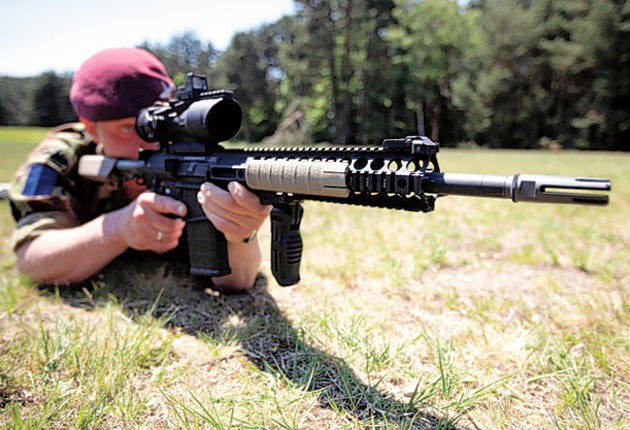Army given new rifles to engage enemies from further away

British troops are to be issued with a new infantry combat rifle for the first time in 20 years to cope with the fierce fighting conditions of the Afghan war.
The Sharpshooter will use larger 7.62mm bullet rounds in order to engage with Taliban fighters over longer distances. The change comes after the military found that the standard Nato 5.66 rounds lost velocity at ranges over a thousand feet.
The 5.56 rounds, used by the SA80 rifles, had proved adequate in previous conflicts in Iraq, Kosovo and Sierra Leone where much of the exchanges had taken place in urban battlegrounds. However, in the valleys and mountains of Afghanistan the insurgents often start shooting matches at distances of up to 2,500 feet. The Taliban, on the other hand, are using guns which can date back to the 1890s but have proved to be effective over further distance and their simpler mechanism makes them easier to maintain. Around 400 of the new rifles have been purchased for £1.5m from funds available under Urgent Operational Requirements (UORs) and will be issued to the most proficient shots.
US forces in Afghanistan have also encountered the same problem with firefights over distances and are currently in the process of modifying some of their M-4 rifles to take the 7.62 rounds which were last used in the early days of the Vietnam War, before being replaced because they were considered too unwieldy for close-quarter jungle warfare. IEDs (improvised explosive devices) have become the chosen weapon of the Taliban, accounting for 92 per cent of recent UK and allied deaths in the conflict. However, the two latest British fatalities, Corporal Terry Webster, 24 and Cpl Alan Cochran, 23, of 1st Battalion The Mercian Regiment were killed in a gun battle at Nahr-e-Saraj in Helmand.
Successive waves of foreign forces in Afghanistan have experienced difficulties with gunfights in the harsh terrain and conditions. British and Indian troops of the Raj found during two Afghan campaigns in the 19th century that their Brown Bess muskets – the most advanced weapon of its kind at the time – were no match for the long- barrelled flintlock Jezzails used by Gilzai tribesmen.
Soviet soldiers fighting in the 1980s found that their AK-47 Kalashnikovs were outgunned in long distance ambushes by the bolt-action Lee-Enfield and Mauser rifles used by the Mujaheddin. Colonel Peter Warden, team leader of the Light Weapons section at the MoD's Defence, Equipment and Support department, said: "The Sharpshooter rifle is very capable and [will] fulfil a specific role on the frontline in Afghanistan. It is a versatile weapon which will give our units a new dimension to their armoury."
British forces have also started receiving the first batches of shotguns for close combat. They will be used for clearing compounds in the rural areas.
British rifles
1720s-1830s: Long Land Pattern Musket is standard issue for the British Empire's land forces.
1776: Pattern 1776 infantry rifle is designed. One thousand are made and issued to British soldiers fighting in the War of American Independence.
1800-1815: Baker rifle is used in the Napoleonic Wars. It continues to be in service in the British Army until the 1840s.
1836: Brunswick rifle, a muzzle-loading weapon, is introduced to replace the Baker and remains in production until 1885.
1888: Magazine rifle mark I is the first British rifle to incorporate a bolt action and a box magazine.
1916: Pattern 1914 rifle is produced by three US firms after British manufacturers delay production during the First World War.
1939: Rifle number 4 mark I is adopted just after the beginning of the Second World War.
1957: Soldiers begin using the L(12A)1 self-loading rifle, a British version of the Belgian FN FAL.
1976: Britain begins trialling prototypes for the 1980s programme, which aims to create weapons to replace the L(12A)1 and the Bren gun. SA80 rifles have since been standard issue.
2010: Marines in 40 Commando begin using Sharpshooter rifle in Afghanistan.
Join our commenting forum
Join thought-provoking conversations, follow other Independent readers and see their replies
Comments
Bookmark popover
Removed from bookmarks